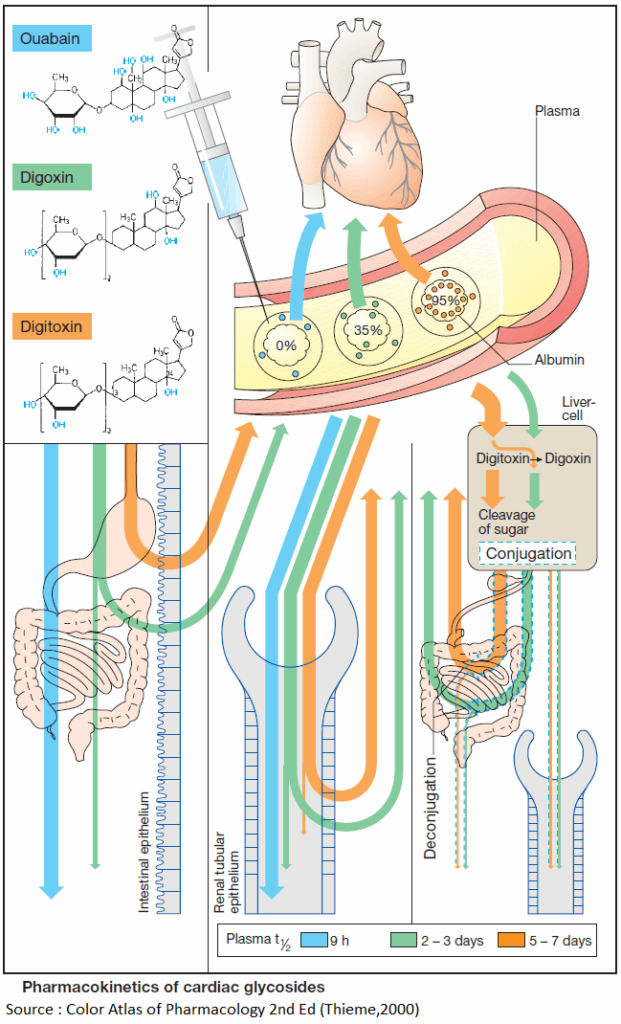Cardiac Glycosides
Diverse plants are sources of sugarcontaining compounds (glycosides) that also contain a steroid ring and augment the contractile force of heart muscle : cardiotonic glycosides / cardiosteroids, or “digitalis”.
If the inotropic, “therapeutic” dose is exceeded by a small increment, signs of poisoning appear: arrhythmia and contracture. The narrow therapeutic margin can be explained by the mechanism of action.
Mechanism of Action of Cardiac Glycosides
Cardiac glycosides (CG) bind to the extracellular side of Na+/K+-ATPases of cardiomyocytes and inhibit enzyme activity. The Na+/K+-ATPases operate to pump out Na+ leaked into the cell and to retrieve K+ leaked from the cell.
In this manner, they maintain the transmembrane gradients for K+ and Na+, the negative resting membrane potential, and the normal electrical excitability of the cell membrane.
When part of the enzyme is occupied and inhibited by CG, the unoccupied remainder can increase its level of activity and maintain Na+ and K+ transport. The effective stimulus is a small elevation of intracellular Na+ concentration (normally approx. 7 mM).
Concomitantly, the amount of Ca2+ mobilized during systole and, thus, contractile force, increases. It is generally thought that the underlying cause is the decrease in the Na+ transmembrane gradient, i.e., the driving force for the Na+/Ca2+ exchange, allowing the intracellular Ca2+ level to rise.
When too many ATPases are blocked, K+ and Na+ homeostasis is deranged; the membrane potential falls, arrhythmias occur. Flooding with Ca2+ prevents relaxation during diastole, resulting in contracture.

CNS Effects of Cardiac Glycosides
The CNS effects of Cardiac Glycosides are also due to binding to Na+/K+-ATPases. Enhanced vagal nerve activity causes a decrease in sinoatrial beating rate and velocity of atrioventricular conduction.
In patients with heart failure, improved circulation also contributes to the reduction in heart rate. Stimulation of the area postrema leads to nausea and vomiting. Disturbances in color vision are evident.
Indications for Cardiac Glycosides
Indications for CG are:
- Chronic congestive heart failure
- Atrial fibrillation or flutter, where inhibition of AV conduction protects the ventricles from excessive atrial impulse activity and thereby improves cardiac performance . Occasionally, sinus rhythm is restored.
Signs of Cardiac Glycoside Intoxication
Signs of intoxication are:
- Cardiac arrhythmias, which under certain circumstances are life-threatening, e.g., sinus bradycardia, AV-block, ventricular extrasystoles, ventricular fibrillation (ECG)
- CNS disturbances — altered color vision (xanthopsia), agitation, confusion, nightmares, hallucinations
- Gastrointestinal — anorexia, nausea, vomiting, diarrhea
- Renal — loss of electrolytes and water, which must be differentiated from mobilization of accumulated edema fluid that occurs with therapeutic dosage.
Therapy of Cardiac Glycoside Intoxication
Therapy of intoxication:
- Administration of K+, which inter alia reduces binding of Cardiac Glycosides, but may impair AV-conduction
- Administration of antiarrhythmics, such as phenytoin or lidocaine
- Oral administration of colestyramine for binding and preventing absorption of digitoxin present in the intestines (enterohepatic cycle)
- Injection of antibody (Fab) fragments that bind and inactivate digitoxin and digoxin. Compared with full antibodies, fragments have superior tissue penetrability, more rapid renal elimination, and lower antigenicity.
Pharmacokinetics of Cardiac Glycosides
The pharmacokinetics of cardiac glycosides are dictated by their polarity, i.e., the number of hydroxyl groups. Membrane penetrability is virtually nil in ouabain, high in digoxin, and very high in digitoxin.
- Ouabain (gstrophanthin) does not penetrate into cells, be they intestinal epithelium, renal tubular, or hepatic cells. At best, it is suitable for acute intravenous induction of glycoside therapy.
- The absorption of digoxin depends on the kind of galenical preparation used and on absorptive conditions in the intestine. Preparations are now of such quality that the derivatives methyldigoxin and acetyldigoxin no longer offer any advantage. Renal reabsorption is incomplete; approx. 30% of the total amount present in the body (s.c. full “digitalizing” dose) is eliminated per day. When renal function is impaired, there is a risk of accumulation.
- Digitoxin undergoes virtually complete reabsorption in gut and kidneys. There is active hepatic biotransformation: cleavage of sugar moieties, hydroxylation at C12 (yielding digoxin), and conjugation to glucuronic acid. Conjugates secreted with bile are subject to enterohepatic cycling ; conjugates reaching the blood are renally eliminated. In renal insufficiency, there is no appreciable accumulation. When digitoxin is withdrawn following overdosage, its effect decays more slowly than does that of digoxin.

Other Positive Inotropic Drugs
The phosphodiesterase inhibitor amrinone can be administered only parenterally for a maximum of 14 days because it is poorly tolerated. A closely related compound is milrinone.
In terms of their positive inotropic effect, β-sympathomimetics, unlike dopamine, are of little therapeutic use; they are also arrhythmogenic and the sensitivity of the β-receptor system declines during continuous stimulation.
Treatment Principles in Chronic Heart Failure
Myocardial insufficiency leads to a decrease in stroke volume and venous congestion with formation of edema. Administration of (thiazide) diuretics offers a therapeutic approach of proven efficacy that is brought about by a decrease in circulating blood volume (decreased venous return) and peripheral resistance, i.e., afterload.
A similar approach is intended with ACE-inhibitors, which act by preventing the synthesis of angiotensin II (vasoconstriction) and reducing the secretion of aldosterone ( fluid retention).
In severe cases of myocardial insufficiency, cardiac glycosides may be added to augment cardiac force and to relieve the symptoms of insufficiency.
In more recent times β-blocker on a long term were found to improve cardiac performance — particularly in idiopathic dilating cardiomyopathy — probably by preventing sympathetic overdrive.
